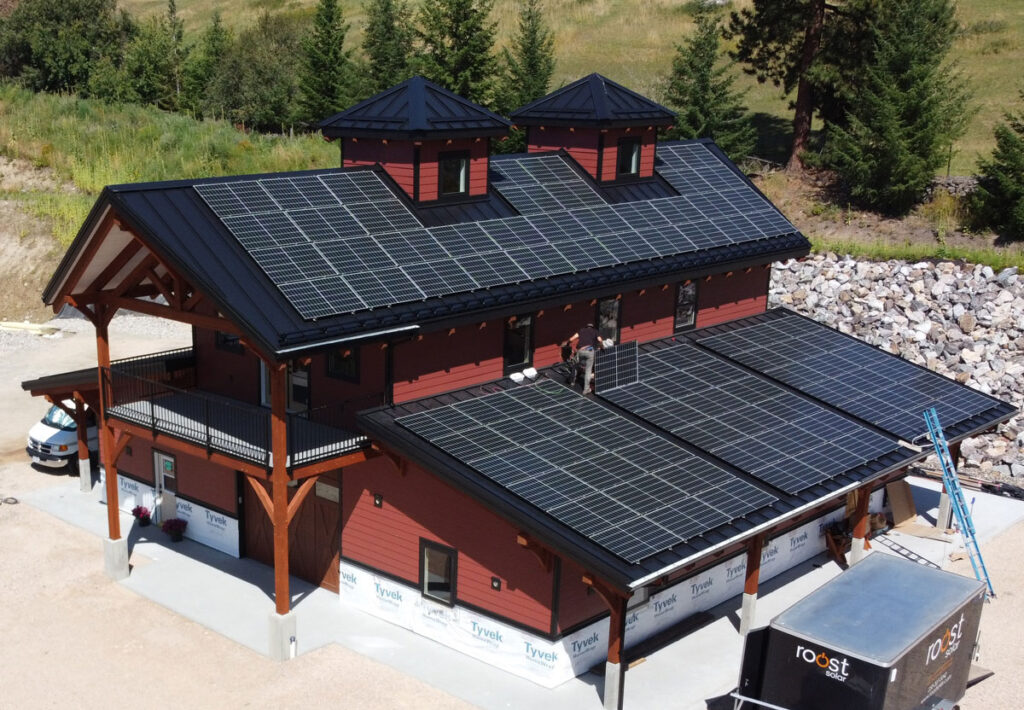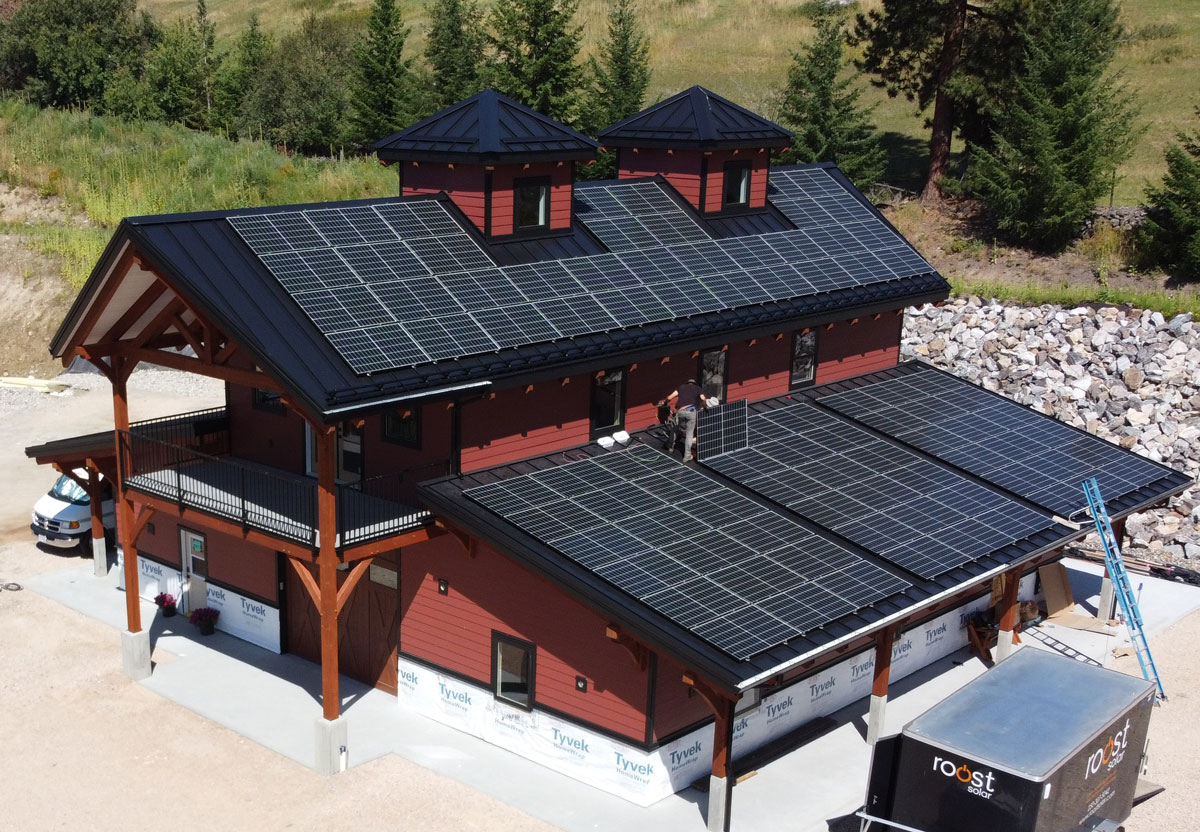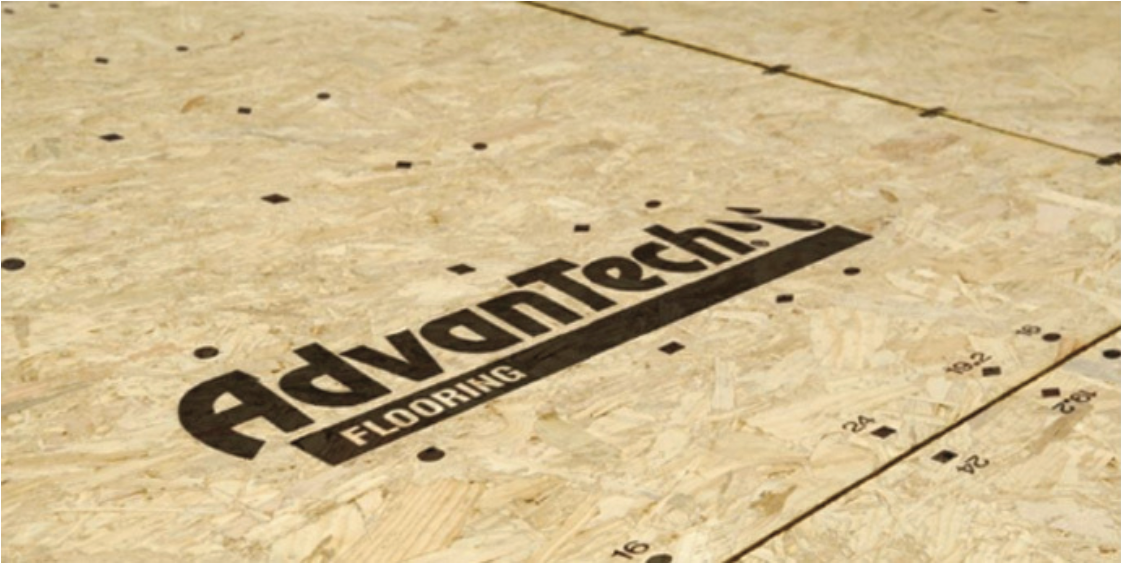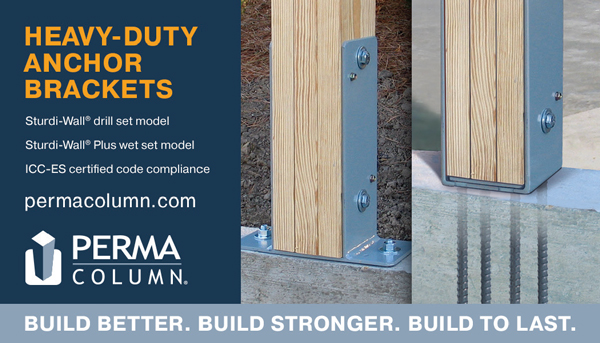By Dan Brownell
The Solar Market Is Currently Small but Poised for Explosive Growth. Builders Have a Chance to Expand
Into Solar Panel System Installations.
Solar panel systems have been used on homes for decades, and they continue to increase in popularity but still account for just a small fraction of the overall residential housing market. According to solarinsure.com, as of 2024, only 4.2 million, or 4.96%, of single-family homes have solar panel systems. While the number is small now, it’s on track for extensive long-term growth.
Solar Growth Over the Long Term
With generous federal and state financial tax and rebate incentives for homeowners, combined with sharply decreasing costs for solar panels, builders have an opportunity to capture some of the remaining 95% of the single-family residences that don’t yet have a solar system.
In addition, the federal initiative to replace gas-powered vehicles with electric vehicles will likely increase demand for solar panels on homes, garages, and carports to reduce or eliminate the cost for charging them. The federal mandates for moving from gas-powered to electric are aggressive. A Forbes.com article dated March 20, said, “The auto industry will meet the new standards if 56% of all new vehicles are electric by 2032, at least 13% are plug-in hybrid or partially electric, and only 29% are traditional combustion engine vehicles, according to the EPA’s regulation.”
An article on na.pansonic.com, also shows a close relationship between an increase in electric vehicles and an increase in residences with solar panels. The article says, “As of March 2023, about 4% of Americans own an EV. Of those EV owners, about one-third have homes fitted with photovoltaic (PV) solar systems and charge their EVs at home. In California (the number one EV ownership state), nearly 40% of EV owners have home PV systems.”
Opportunities for Builders Have Mostly Been Overlooked
Solar system installations are a largely untapped revenue stream for builders. According to Mark Gies, director of strategy and market development for S-5!, solar panel system specialists are currently doing the lion’s share of the solar panel installation work. “Builders are generally just not doing solar, and I think that’s a shame because I think builders, roofers, and contractors could make more money if they got into doing solar themselves,” he said.






Gies pointed out that dedicated solar installers usually work under a general contractor, or they install after the rest of the construction is complete. “A lot of solar is sold after the fact. You would think a lot more would be spec’ed in and would happen on new buildings, but generally somebody builds a house and then they say six months later, ‘OK, now I’m going to put solar up’ and the planning seems disconnected. Or they knew they were going to do it, but they were just going to get the house built first, move in, and then worry about it.”
Jon Shenski, builder and co-owner of Northern Neck Pole Buildings, agreed with this perspective. “Usually when we build a custom barndominium, the client never talks about solar to us, even if it is in their future,” he said.
“I think there are opportunities for change in that world,” Gies noted. “The roof and the solar system should be viewed as one system. If you’re doing it all at once as you build the building and the roof, you can incorporate things that make it more feasible for solar. So there are definitely benefits to upfront planning.
“I was at a recent event and had the opportunity to speak with some builders,” Gies added. “They said that sometimes they’re putting a building together and finishing the roof. They take their ladder down, and as they’re driving away, somebody else is driving up, putting another ladder up, and they go up on the roof to install solar. I said, ‘You know, that could be your money if you expanded your business offerings.’ For some reason, the electrical contracting industry has taken over all aspects of solar installations. There’s no reason why the building industry couldn’t do that as well. I talk about that a lot.
“There are definitely opportunities for the roofing industry to expand vertically and to integrate solar installations. They would have to hire electricians, but installing on roofs is a natural fit for a roofer, because they’re the ones who know roofing. Not enough solar installers know roofing. So, there are opportunities for growth in solar installations in the roofing industry and the building industry overall.
“There’s an organization called NABCEP [North American Board of Certified Energy Practitioners]. They’re one of the organizations that will certify people to become official solar installers. A lot of electrical companies say, “Yeah, we have certified installers on staff.’ But they’re just electricians who just took some courses and took the test.”
According to Gies, if an electrical company can hire certified solar installers, builders should be able to as well and compete with electrical companies for those same solar contracts. There are potential roofing sales opportunities too. Because a roof may need to be replaced on an existing building before a solar system is added, that’s another area of synergy for roofers and builders.
A Caveat About Recent Economic Headwinds
Although the long-term future of solar looks bright, certain segments of the solar market have suffered significant setbacks in the last two years. Solarinsure.com explains on its website that “2023 has brought immense challenges, with higher interest rates, tighter financing, and adverse policy shifts in key states contributing to over 100 solar bankruptcies based on our industry data, a number unseen before in our almost 20 years in the solar sector.”
As is often the case, companies with a strong foundation survive and grow, while financial storms weed out the weak ones. There is great opportunity in the solar sector, but builders should do due diligence to ensure that the solar companies that they’re working with are well-positioned to navigate the economy. But this is another argument for builders to do their own solar installations. It not only increases the potential for profit but could also decrease risk because it brings control in-house.
It should also be noted that while growth in the solar residential sector skyrocketed in recent years, it has slowed in the last year, according to a Solar Energies Industries Association (SEIA) market report updated in March 2024 (seia.org/solar-industry-research-data). The report states, “Nearly 7 GW of residential solar were installed in 2023, marking the 5th consecutive record year for the segment. High household electricity bills and power outages have driven demand, as have changes to California’s Net Metering rules. Customers in California rushed to sign up for projects under the old, more favorable rules before they expired in Spring 2023, and build out of that pipeline propped up national installation volumes in 2023. In 2024 however, the buildout of the California queue coupled with higher financing costs nationally will lead to an overall contraction in the residential market, despite modest growth in non-California markets.”
Another factor that could affect solar growth would be a change in administration and polices after the November election. However, the federal solar tax break is scheduled to last through 2034, which should help soften the uncertainty, and the overall long-term momentum of solar would seem likely to overcome short-term slowdowns.
This long-term momentum is buoyed by a mid-April announcement of a breakthrough in solar panel technology. According to an article published April 13 on thedebrief.org, “A new material capable of greatly improving the efficiency of solar power systems reportedly raised the quantum efficiency of solar panels to an unprecedented 190%…. Traditional solar cells possess a maximum external quantum efficiency (EQE) of 100%, which means they can generate and collect a single electron for each photon they absorb through sunlight collected… The efficiency displayed by the new prototype tested by the Lehigh University team far exceeds the current theoretical limits for conventional silicon-based materials used in such PV systems and could potentially revolutionize the field involving the quantum materials they rely on.”
The Basics of Solar Panel Systems
Since solar panel systems are currently used in only a small part of the residential market, many builders may have little or no direct experience with solar. An inexperienced builder could face a couple of scenarios. The first is a customer who requests a solar system to be integrated with a new residential structure. In that situation, it’s best that the builder work with the customer at the very beginning stages to create a plan to accommodate solar power, as it affects so many aspects of the construction planning, including building location and orientation. A south facing roof angled at 30 to 45 degrees and that’s not shaded by buildings, trees, or other obstructions is best.
On the other hand, if a customer asks for a solar system to be installed on an already existing structure, there will be more constraints to work around. In that situation, the panels might need to be installed in a direction or at an angle that’s less than ideal. Another factor to consider is the type, age, and condition of the roof of an existing building. It might not be able to support the weight of a panel system.
Or if it’s an asphalt roof that’s already old, it would need to be replaced before the solar panel system is installed. Otherwise, at some point, the solar panels will need to be removed, a new roof installed, and then solar panels replaced, which would add so much cost that it could make the solar system financially impractical. That issue might not be a factor, however, if the current roof is a metal roof in good condition with an expected life span that’s longer than the anticipated life span of the solar panels.
In any case, if the general contractor and/or builder don’t do the solar work themselves, they will need to work with a licensed solar panel company to do the planning and installation of the system. The design needs specialized knowledge. For instance, the calculation to determine the optimum panel setup for a structure can be complex because so many variables are involved. There are many solar system companies to choose from. Builders and homeowners should do careful research to find a reliable company with good reviews and warranties.
Homeowners should also consult their insurance company, as solar panels can raise insurance rates. Although wind and hail coverage for panels might be included in a standard insurance policy, a solar panel system would likely raise the value of the home and increase the rates for that reason.
While the increased home value could help homeowners get a higher amount for their home when they do sell, it could cause a home to take longer to sell on the market, depending on policies of the state or region. According to the website unbound.com, “Solar homes may languish on the market for much longer when there is no incentive for owning a solar-enabled home.”
Unbound.com also points out that “Solar education in lower adoption states can be a major stumbling block. In many cases, buyers don’t understand the difference between grid-tie and off-grid systems. They tend to assume all solar energy systems are off-grid, which rely on panels to generate 100% of their energy and run entirely on a battery storage system. The fear is that they’ll be stuck without power if the solar array goes out and they don’t know how to fix it…. In areas where solar energy is less popular, a little education may be necessary to convince buyers that a PV system is a reliable way to power their home.” For more details on how solar impacts home sales, visit unboundsolar.com/blog/do-solar-panels-increase-home-value.
Once an on-grid solar system is installed, it will need an inspection and Permission to Operate (PTO) from the utility company. If the building and solar systems are done by separate companies, the GC or builder’s role is to meet the building’s structural requirements, ensuring that the proper permits, codes, and zoning for the structure are done completely and correctly. The solar panel installation company is responsible for the permits and codes for installing the solar system and the electrical work.
Even if the builder doesn’t do solar installation, having a good knowledge of solar panel systems is helpful because as part of the initial planning conversation with the homeowners, the builder can help the customer do a preliminary review of solar requirements and costs to help answer basic questions. Several online tools are available, such as a peak sun hours map and a solar calculator to determine whether it makes sense financially to invest in a solar panel system for the client’s particular situation.
A peak sun hours map shows the average peak hours of sun for each state. In the continental United States, that varies between 3.5 and 6 hours. A solar calculator can help a builder and homeowner do the math on the system size needed, its estimated cost, tax incentives and rebates, potential monthly savings, and estimated number of years to reach the payback point.
Monthly Peak Sun Hours Maps
• solarreviews.com/blog/how-many-solar-panels-do-i-need-to-run-my-house
• https://unboundsolar.com/solar-information/sun-hours-us-map
Solar Calculators
• solarreviews.com/solar-calculator
• https://unboundsolar.com/solar-information/solar-cost
Planning a Solar Panel System
If, after an initial review with the builder, the customer decides in favor of a solar system, the solar installation company will evaluate the customer’s current structure or proposed new one and its site characteristics, such as its geographic location, average light per day, roof size, position on the property, obstructions that could block sunlight, direction and angle of the roof, roofing material and age, and power requirements to determine if the proposed system will deliver the results needed and, if so, the number of solar panels needed and whether the roof is strong enough to support the solar panels system and handle wind uplift and snow loads. A reputable solar installer will use proper attachments to connect the solar panels to the roof.
Solar Glossary
Inverter: A device that converts DC power to AC power
String: The group of panels connected to a single inverter
Array: All the solar strings connected to form a solar system
PV: Photovoltaic (PV) panels that comprise a solar panel system
Solar Panel System Types
On-Grid (Tied In)
An on-grid solar panel system ties into an existing power grid through a utility company, typically using a net metering system, which is a two-way connection to the power grid that measures how much is drawn from the grid when the solar panel is not producing electricity, as well as the amount of excess electricity the solar panel system contributes to the power grid. With the net metering system, the utility applies a credit to the solar panel owner for electricity produced above what is drawn from the grid.
The disadvantage of net metering is that some utility companies sell their power at high retail rates but credit the excess power from solar panels at a much lower wholesale rate. Sometimes the rates vary depending on the time of day and the corresponding level of power demand on the grid. Homeowners should evaluate the utility company’s terms carefully before committing to a long-term plan in which a decision is based heavily on the ability to sell power back to the utility. For more information on net metering, visit solarreviews.com/blog/what-is-net-metering-and-how-does-it-work.
Off-Grid
An off-grid system is not connected to the existing power grid. That means it’s totally dependent on solar panels for electricity. It won’t be able to draw any power from a power line when the solar panels can’t keep up with demand. For that reason, a battery storage system is essential to store power for times when the panels aren’t producing power, which would be the majority of a 24-hour period.
However, a battery backup isn’t a practical solution to power all the electrical needs of a home for an extended period. In fact, it’s only expected to provide power for essential appliances, such as a refrigerator and lights for around eight hours on a single charge. That’s enough to help with a power outage from a storm, but not a dependable long-term replacement for electrical power.
For this reason, off-grid systems are only practical for limited power requirements such as garage or shed, especially if it is either inaccessible to an on-grid power line or is so far from a house (or other structure with an existing power line) that the cost of digging a trench and running wire from it is cost prohibitive.
For situations in which an off-grid system is the best choice, an inverter is needed to convert the DC charge generated by the solar panels into AC current used by standard household receptacles. The system also needs a solar charge controller to regulate the current and voltage supplied by the solar panels to allow safe and efficient battery charging.
An off-grid system is also practical for smaller structures and lower power needs such as running an overhead light and device charger, etc. in a shed or garage. Some small solar panel systems are available in DIY kits, typically 200W or less, which don’t need a permit or inspection since they’re low power and not tied into the grid. For more information, visit marketwatch.com/guides/solar/solar-power-for-shed. Small off-grid solar vents can also be added to sheds, garages, attics, greenhouses, and other small structures to control heat, improve air circulation, and lower humidity.
Hybrid
A hybrid solar panel system is both tied into the power grid and has a backup battery system. While a battery backup system is very expensive, it does offer a couple of advantages. First, it provides backup power during a power outage on the grid. Second, it can allow homeowners to store power during times of the day when power rates are low and to meter them back to the grid during high-demand/high-rate hours so the owner can be credited with the higher rates. However, with this strategy, the payback period for batteries can be quite long — 20 to 30 years, according to some sources. So, the biggest benefit of a hybrid system isn’t making money by selling power back to the utility but having backup power during a power outage.
Charging Electric Vehicles with Solar Panels
While it’s most common to have an EV charging system that’s tied into the grid, an off-grid solar panel system can completely recharge an electric vehicle if it’s connected to an adequate number of panels exclusively dedicated to it. The typical number of dedicated panels varies from 7 to 12 depending on the type of vehicle, driving habits, area of country, etc. An off-grid system would also typically have a battery storage system to store electricity when the panels aren’t producing power. For more information, visit energysage.com/ev-charging/how-many-panels-do-you-need-for-your-ev.
The Federal Solar Tax Credit (ITC)
From 2024 to 2032, the federal solar tax credit, known as the Investment Tax Credit or ITC, is 30% for qualified solar electric costs, including solar panels, other components such as wiring and inverters, mounting equipment, batteries, labor, and sales tax. To qualify for the tax credit, the solar installer must be licensed, and the applicant must own the system (not lease it), and it must be on-grid. Some solar system companies will only install residential installations that are on-grid. The federal solar tax credit will decrease to 26% in 2033, to 22% in 2034, and will be eliminated completely in 2035 unless renewed by Congress. For more details, visit marketwatch.com/guides/solar/federal-solar-tax-credits.
Other Solar Incentives
In addition to the federal solar tax credit, other incentives are available, such as rebates, subsidies, low-interest loans, and state tax credits. These vary according to area and timeframe. Find more information from the following sources:
• dsireusa.org
• https://unboundsolar.com/solar-information/state-solar-incentives
• forbes.com/home-improvement/solar/solar-tax-credit-by-state
• solarreviews.com/blog/the-top-solar-incentive-programs-in-the-us
Solar Installers
Following are several sources for lists of solar companies.
• solarreviews.com/solar-companies
• solarpowerworldonline.com/top-solar-contractors
Other Solar Information and Resources
• energy.gov/eere/solar/homeowners-guide-going-solar
• energysage.com
• solarunitedneighbors.org/go-solar/faqs
• mobenosolarsolutions.com
GSCB























